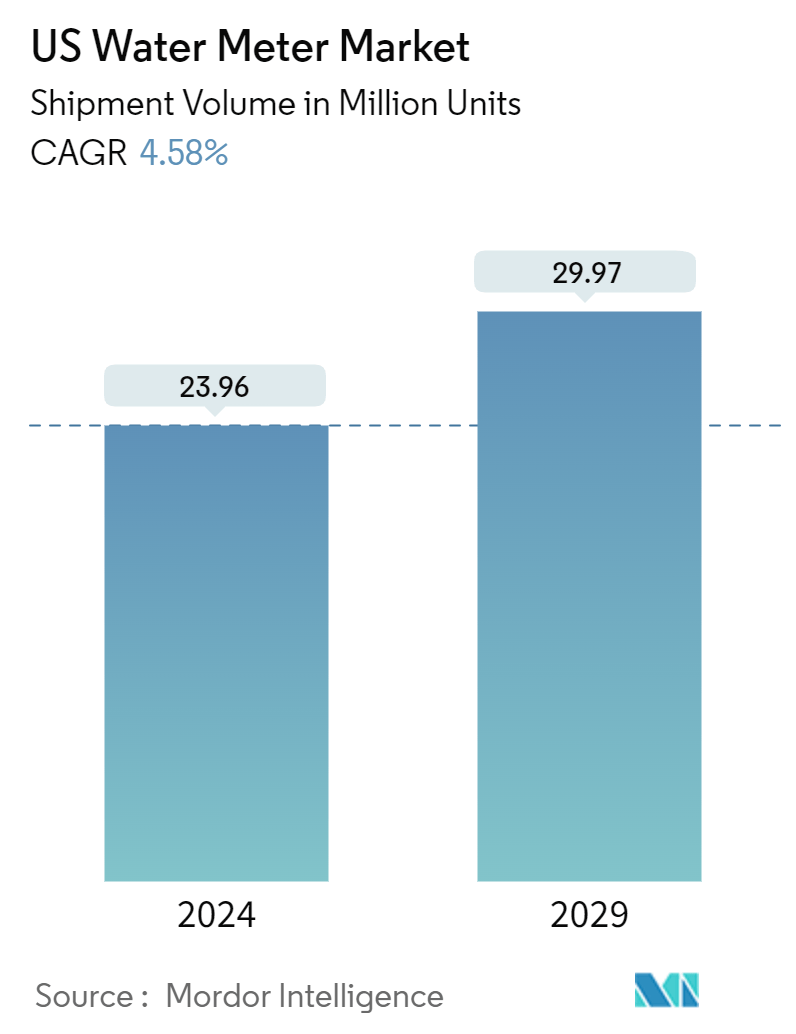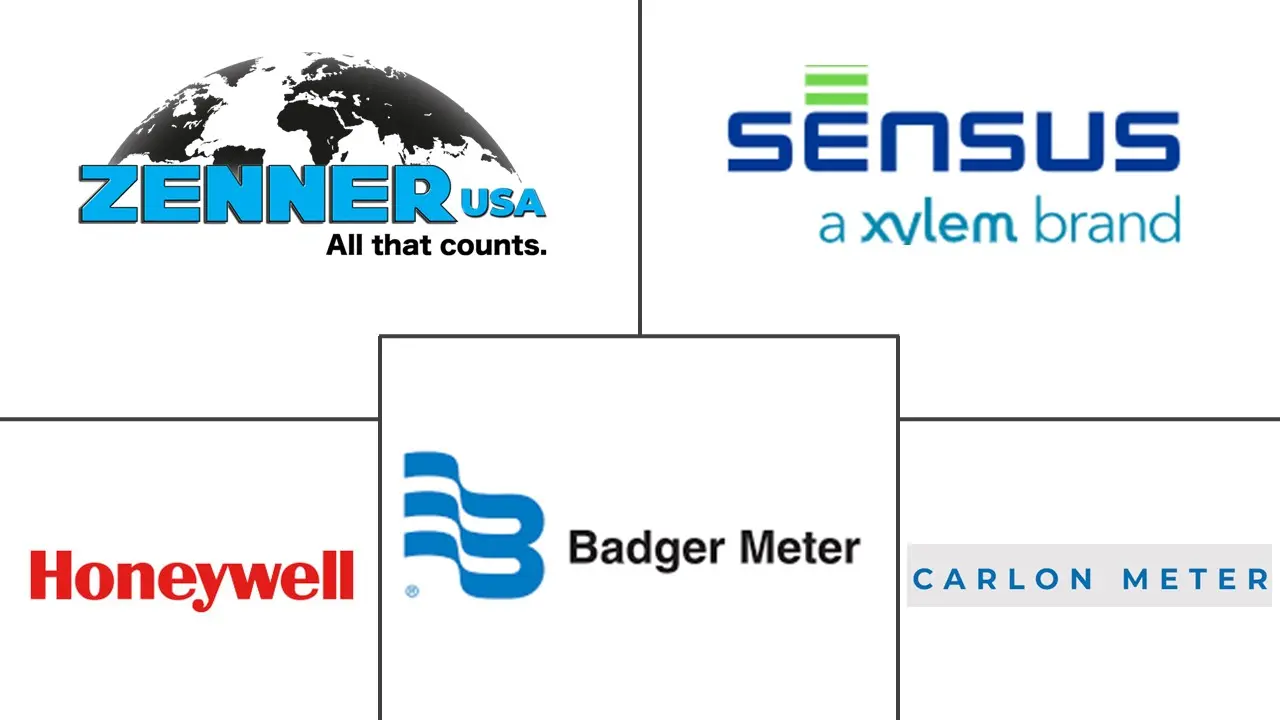Market Size of US Water Meter Industry

| Study Period | 2019 - 2029 |
| Base Year For Estimation | 2023 |
| Forecast Data Period | 2024 - 2029 |
| Historical Data Period | 2019 - 2022 |
| CAGR (2024 - 2029) | 4.58 % |
| Market Concentration | Low |
Major Players
*Disclaimer: Major Players sorted in no particular order |
US Water Meter Market Analysis
The US Water Meter Market size in terms of shipment volume is expected to grow from 23.96 Million units in 2024 to 29.97 Million units by 2029, at a CAGR of 4.58% during the forecast period (2024-2029).
- Water meters are primarily used to measure the volume of water flowing through a pipe. This could either be the main water supply pipe of a building, facility, or an entire facility, or a sub-zone, like a refrigeration process unit in an industrial space. Water meters usually measure this volume in gallons or cubic feet. Over the years, water meter technology has evolved significantly from basic mechanical meters to electromagnetic, ultrasonic, and the most advanced smart meters.
- The adoption of water meters has several advantages, as it helps the user understand their bills and consumption patterns. By analyzing the meter data, they can also determine how much water was consumed over a period by keeping a simple log. Modern smart meters enable users to determine the amount of water used during an event, such as facility cleaning, and detect water flowing that they do not intend to use, such as water theft and leakage.
- The United States is among the key markets for water meters as the country has a high rate of urbanization and is among the leading spenders on water supply infrastructure. Furthermore, the high penetration of advanced technologies among businesses and consumers makes the country a lucrative smart water meter market landscape. According to the American Society of Civil Engineers, the country's drinking water infrastructure system comprises underground pipes stretching over 2.2 million miles, delivering safe, reliable water to millions of inhabitants.
- Recent years have witnessed significant growth in public and private investments aimed at modernizing the country's water supply infrastructure and promoting water conservation, which is among the major factors driving the growth of the market studied. For instance, in May 2024, The Bloomington and Normal Water Reclamation District in central Illinois was granted a USD 39 million loan by the US Environmental Protection Agency (EPA) through the Water Infrastructure Finance and Innovation Act (WIFIA). This loan plays a crucial role in funding the district's Wastewater System Modernization and Rehabilitation Program, which aims to ensure public health and environmental safety while also promoting economic development.
- The rate of urbanization in the United States is among the highest in the world. According to the data provided by the University of Michigan, currently, about 83% of the US population lives in urban areas, which is anticipated to grow beyond 89% by 2050. As water is a crucial requirement for the survival of the population, the growing urban population is also anticipated to drive the demand for water and supply infrastructure, which in turn will create opportunities in the market studied.
- However, factors such as a higher installation and maintenance cost of water meters, especially smart water meters, along with integration challenges in remote areas and within old infrastructures, continue to remain key challenging factors for the growth of the market studied.
- Furthermore, the economic condition of a country significantly affects the infrastructure development of a region, which is expected to impact the growth of the market under study. In the United States, a considerable amount of funding for water supply infrastructure development is sourced from the public sector. Consequently, variations in economic growth could constrain the government's ability to invest in new projects or technologies, leading to an unfavorable environment for the market's expansion.
US Water Meter Industry Segmentation
Water meters are devices used to measure the quantity/volume of water passing through a supply pipeline/outlet. This may include the primary water supply pipeline for an entire facility or a sub-zone, like a refrigeration/boiler process. Measurements can be made in units, including cubic feet or gallons.
The US water meter market is segmented by type of meter (smart water meter and basic water meter). The market sizes and forecasts are provided in terms of volume (Units) for the above segment.
| By Type | |
| Smart Water Meter | |
| Basic Water Meter |
US Water Meter Market Size Summary
The US water meter market is poised for significant growth, driven by the increasing demand for efficient water management solutions and the adoption of advanced metering technologies. Water meters, essential for measuring water flow in various settings, have evolved from basic mechanical devices to sophisticated smart meters that offer real-time data and analytics. This evolution is particularly relevant in the United States, where urbanization and substantial investments in water supply infrastructure are prevalent. The country's commitment to modernizing its water infrastructure, supported by government initiatives and funding, underscores the importance of water meters in promoting water conservation and efficiency. The integration of technologies such as LoRaWAN and 5G networks further enhances the capabilities of smart meters, facilitating better connectivity and data transmission.
The market landscape is characterized by the presence of major players like Zenner USA Inc., Sensus USA Inc. (Xylem Inc.), Badger Meter Inc., Honeywell International Inc., and Carlon Meter Inc., who are actively engaging in strategic partnerships and acquisitions to strengthen their market position. The ongoing development and deployment of smart metering projects across various states, coupled with the supportive regulatory environment, are expected to drive the demand for smart water meters. Innovations such as the launch of new ultrasonic meters and the deployment of advanced metering infrastructure solutions highlight the dynamic nature of the market. Despite challenges like high installation costs and integration issues in older infrastructures, the US water meter market is set to expand, driven by technological advancements and increased investment in water management infrastructure.
US Water Meter Market Size - Table of Contents
-
1. MARKET INSIGHTS
-
1.1 Market Overview
-
1.2 Industry Attractiveness - Porter's Five Forces Analysis
-
1.2.1 Bargaining Power of Suppliers
-
1.2.2 Bargaining Power of Buyers
-
1.2.3 Threat of New Entrants
-
1.2.4 Threat of Substitute Products
-
1.2.5 Degree of Competition
-
-
1.3 Industry Value Chain Analysis
-
1.4 Impact of COVID-19 Aftereffects and Other Macroeconomic Factors on the Market
-
-
2. MARKET SEGMENTATION
-
2.1 By Type
-
2.1.1 Smart Water Meter
-
2.1.2 Basic Water Meter
-
-
US Water Meter Market Size FAQs
How big is the US Water Meter Market?
The US Water Meter Market size is expected to reach 23.96 million units in 2024 and grow at a CAGR of 4.58% to reach 29.97 million units by 2029.
What is the current US Water Meter Market size?
In 2024, the US Water Meter Market size is expected to reach 23.96 million units.

